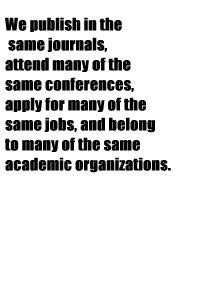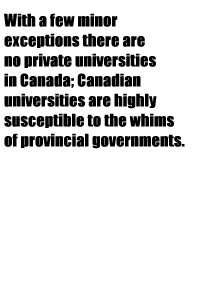

Douglas Ivison
2. Canadian academics, including graduate students, may seem remarkably similar to American ones. After all, we publish in the same journals, attend many of the same conferences, apply for many of the same jobs, and belong to many of the same academic organizations, such as the MLA. Yet, there are a number of significant differences, with which many Americans may be unfamiliar, which have an impact on Canadian graduate students, as both students and workers.
3. Canadian universities are virtually all state funded and controlled. With a few minor exceptions there are no private universities in Canada. While many universities were established by churches, those ties have for the most part been erased, and provincial governments have a great impact on university policy. As a result, Canadian universities are highly susceptible to the whims of provincial governments, who are primarily responsible for funding post-secondary education. This has had a very negative impact on universities in the 1990s, as most provinces have been gripped by deficit reduction fever.
4. Tuition has traditionally been lower than at many American universities. Until recently, tuition in Canada has been quite low by American standards, only $2000 or $3000 CAN, with many universities charging much lower tuition for ABD students. It is possibly for this reason that Canadian graduate students have not traditionally demanded or expected tuition remission. Unfortunately, over the past decade tuition has risen dramatically in some provinces. As a result of the mid-1990s drive to achieve balanced budgets, funding for post-secondary education has been drastically restricted. In some provinces, this has resulted in the at least partial deregulation of tuition, which has resulted in rapidly rising tuition fees. In those provinces which have maintained low tuition--such as Québec-- universities have resorted to increased user fees and the elimination of reduced tuition for ABD students. Now, many graduate students are finding that their funding packages barely pay for their tuition, if that.
5. Tuition remission is virtually nonexistent in Canadian universities.
As noted above, tuition has traditionally been relatively low in Canada,
which has made this a less valuable benefit than in higher-tuition institutions.
Some universities do grant tuition remission to those graduate students
who have been successful in competitions for province-wide or nation-wide
scholarships like the SSHRC (Social Sciences and Humanities Research Council
of Canada) Doctoral Fellowships. Tuition remission, in the rare cases in
which it has been granted, has been seen more as a tool for attracting
the 'best' graduate students than as a work-related benefit.
Unlike in many American departments, the MA is a distinct degree, which
takes anywhere from 1 to 3 years (for most full-time students). While some
departments have course-based MA's, many departments require course work
and either a thesis or comprehensive examinations. In most departments,
few MA students receive substantial funding. Some programs do offer MA
students the opportunity to be a teaching assistant, whether as a seminar
leader or simply as a researcher/marker. Many, if not most, MA's who go
on to do a PhD do so at a different program, and for many graduate students
the MA is a terminal degree. The resultant high turnover in MA students
frequently makes it more difficult to organize them, for they are often
reluctant to participate in strikes or other actions since they will most
likely no longer be in the program when the benefits are realized.
6. In most departments, the PhD program (more course work, comprehensive examinations, and dissertation) is expected to take 4 years to complete, though most doctoral students take at least 5 years. PhD students may receive funding from the university, and/or nationally- and provincially-awarded scholarships (most of which are only tenable for the first 3 or 4 years of the PhD), but many are dependent upon their salaries as teaching assistants (which vary widely from university to university) to pay their tuition and living expenses. At some universities PhD students principally work as teaching assistants (leading seminars and marking) while at others they principally work as course instructors (frequently composition or introductory literature courses).
7. Graduate students receiving funding are theoretically restricted to working 10 hours a week (both academic and non-academic jobs) by provincial or university policy. There is no equivalent to the MLA, and thus the MLA Graduate Student Caucus, in Canada. ACCUTE (Association of Canadian College and University Teachers of English) is one of the largest humanities associations but it can boast, at best, only between 200 and 300 graduate students (approx. 25-33% of membership). While there have been recent attempts to create a more active GSC in ACCUTE, its ability to act is hindered by the fact that, unlike the MLA GSC, it can only speak for graduate students in English, and not those in other related disciplines. Thus there is no clear national voice on these issues.
8. Unions are probably a less controversial presence in Canadian universities than in the USA. As Canadian universities are state institutions, and their employees essentially public employees, unions representing faculty, support staff and graduate student employees have been a presence on many Canadian campuses since at least the 1970s. Administrations are thus, for the most part, less openly hostile to unions than in the USA. This varies from province to province, however, with some provincial governments, such as that of Ontario, becoming actively anti-union in recent years.
Douglas Ivison,University of Western Ontario & Memorial University of Newfoundland (douglasivison@hotmail.com)
   |